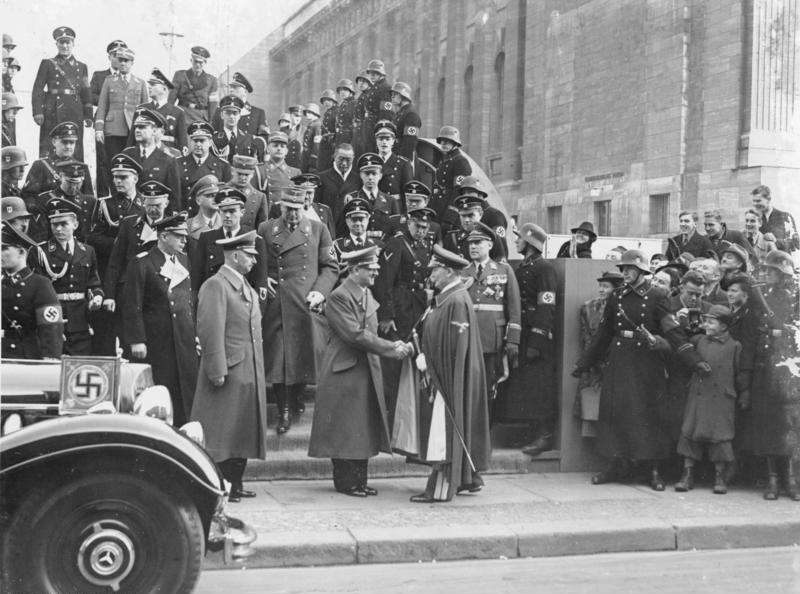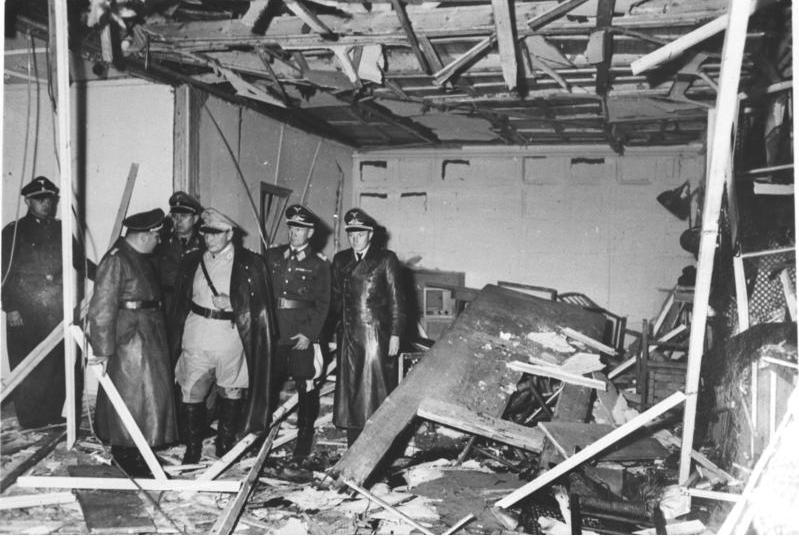|
Reichssicherheitsdienst
The ''Reichssicherheitsdienst'' (RSD, lit. "Reich security service") was an SS security force of Nazi Germany. Originally bodyguards for Adolf Hitler, it later provided men for the protection of other high-ranking leaders of the Nazi regime. The group, although similar in name, was completely separate from the ''Sicherheitsdienst'' (SD), which was the formal intelligence service for the SS, the Nazi Party and later Nazi Germany. Its role included personal security, investigation of assassination plots, surveillance of locations before the arrival of Nazi dignitaries and vetting buildings as well as guests. The RSD had the power to request assistance from any other SS organisations and take command of all ''Ordnungspolizei'' (order police) in its role protecting the Nazi functionaries. Formation The RSD was founded on 15 March 1933 as the ''Führerschutzkommando'' ("Führer protection command"; FSK) under the command of then SS-''Standartenführer'' Johann Rattenhuber. His deputy ... [...More Info...] [...Related Items...] OR: [Wikipedia] [Google] [Baidu] |
Adolf Hitler's Bodyguard
Adolf Hitler, the dictator of Nazi Germany, initiated World War II in Europe with the invasion of Poland in September 1939 and was central to the Holocaust. He was hated by his persecuted enemies and even by some of his own countrymen. Although attempts were made to assassinate him, none were successful. Hitler had numerous bodyguard units over the years which provided security. When Hitler returned to Munich from military service in 1918, he became a member of the Nazi Party, an extremist far-right political party in Bavaria. In 1921, he was elected leader of the party. As his speeches promoted violence and racism, Hitler needed permanent security. Founded in 1920, the '' Sturmabteilung'' (SA) was the first of many paramilitary protection squads that worked to protect Nazi officials. In 1923, a small bodyguard unit, which became known as the '' Stosstrupp-Hitler'' (SSH), was set up specifically for Hitler's protection. It was under the control of the SA. Then in 1925, a ... [...More Info...] [...Related Items...] OR: [Wikipedia] [Google] [Baidu] |
Johann Rattenhuber
Johann Rattenhuber (30 April 1897 – 30 June 1957), also known as Hans Rattenhuber, was a German police and SS general (''Gruppenführer'', i. e. Generalleutnant). Rattenhuber was the head of German dictator Adolf Hitler's personal ''Reichssicherheitsdienst'' (Reich Security Service; RSD) bodyguard from 1933 to 1945. In January 1942, Rattenhuber's RSD units participated in the mass shooting of 227 Jews at Strizhavka. After the war, he was released from Soviet prison on 10 October 1955 and allowed to go to West Germany. He died in Munich in 1957. Biography Rattenhuber was born in Munich, where he made a career as a police officer. During World War I he served in the 16th and 13th Bavarian Infantry Regiments. He later joined the ''Freikorps''. On 15 March 1933 he was appointed head of one of Hitler's personal bodyguard units then known as the ''Führerschutzkommando'' (Führer protection command; FSK). His deputy was Peter Högl. Its original members were Bavarian criminal-po ... [...More Info...] [...Related Items...] OR: [Wikipedia] [Google] [Baidu] |
Peter Högl
Peter Högl (19 August 1897 – 2 May 1945) was a German people, German officer holding the rank of SS-''Obersturmbannführer'' (lieutenant colonel) who was a member of one of Adolf Hitler's bodyguard units. He spent time in the ''Führerbunker'' in Berlin at the end of World War II. Högl later died from wounds received during the break-out on 2 May 1945 while crossing the Weidendammer Bridge under heavy fire in Berlin. Early life and career Högl was born near Dingolfing in Bavaria. After he left school he worked as a miller in Landshut until he joined the 16th Bavarian Infantry Regiment in 1916; there, he then saw active service in World War I and reached the rank of ''Unteroffizier''. He left the army in 1919 and joined the Bavarian police, transferring to the criminal police in 1932. He rose to the position of ''Kriminalrat'' in the ''Kriminalpolizei (Nazi Germany), Kriminalpolizei''. Nazi career He joined the SS (member number: 249,998) and became a member of Adolf Hitler' ... [...More Info...] [...Related Items...] OR: [Wikipedia] [Google] [Baidu] |
SS-Begleitkommando Des Führers
''SS-Begleitkommando des Führers'' ("SS Escort Command of the Führer"; SS-BKdF), later known as the ''Führerbegleitkommando'' ("Führer Escort Command"; FBK), was originally an eight-man SS squad formed from a twelve-man security squad (known as the ''SS-Begleitkommando'') tasked with protecting the life of Adolf Hitler during the early 1930s. Another bodyguard unit, the ''Reichssicherheitsdienst'' (Reich Security Service; RSD) was formed 1933, and by the following year replaced the FBK in providing Hitler's overall security throughout Germany. The FBK continued under separate command from the RSD and provided close, personal security for Hitler. The two units worked together for Hitler's security and protection, especially during trips and public events, though they operated at such events as separate groups and used separate vehicles. When the FBK unit was expanded, the additional officers and men were selected from the Leibstandarte SS Adolf Hitler (LSSAH). The majority o ... [...More Info...] [...Related Items...] OR: [Wikipedia] [Google] [Baidu] |
Schutzstaffel
The ''Schutzstaffel'' (SS; also stylized as ''ᛋᛋ'' with Armanen runes; ; "Protection Squadron") was a major paramilitary organization under Adolf Hitler and the Nazi Party in Nazi Germany, and later throughout German-occupied Europe during World War II. It began with a small guard unit known as the ''Saal-Schutz'' ("Hall Security") made up of party volunteers to provide security for party meetings in Munich. In 1925, Heinrich Himmler joined the unit, which had by then been reformed and given its final name. Under his direction (1929–1945) it grew from a small paramilitary formation during the Weimar Republic to one of the most powerful organizations in Nazi Germany. From the time of the Nazi Party's rise to power until the regime's collapse in 1945, the SS was the foremost agency of security, surveillance, and terror within Germany and German-occupied Europe. The two main constituent groups were the '' Allgemeine SS'' (General SS) and ''Waffen-SS'' (Armed SS). The ' ... [...More Info...] [...Related Items...] OR: [Wikipedia] [Google] [Baidu] |
Julius Schaub
Julius Schaub (20 August 1898 – 27 December 1967) was the chief aide and adjutant to German dictator Adolf Hitler until the dictator's suicide on 30 April 1945. Born in 1898 in Munich, Bavaria, Schaub served as a field medic during World War I, during which he injured both of his feet. During the hard times which followed the War, Schaub joined the Nazi Party. After losing his job because of his membership, Hitler hired him as his personal aide, a position he held for 25 years. Schaub took care of Hitler's personal belongings, papers and travel journeys, making him a notable figure in Hitler's inner circle. In 1924, he was imprisoned with Hitler for his involvement in the coup d'état attempt of November 1923 in Munich. In time he closely befriended Hitler. Later in July 1944, Schaub was not present during the military briefing in a ''Wolfsschanze'' barrack in which a bomb exploded in an attempt on Hitler's life, killing four people and injuring twenty others. Schaub was ... [...More Info...] [...Related Items...] OR: [Wikipedia] [Google] [Baidu] |
Nazi Party
The Nazi Party, officially the National Socialist German Workers' Party (german: Nationalsozialistische Deutsche Arbeiterpartei or NSDAP), was a far-right politics, far-right political party in Germany active between 1920 and 1945 that created and supported the ideology of Nazism. Its precursor, the German Workers' Party (; DAP), existed from 1919 to 1920. The Nazi Party emerged from the Extremism, extremist German nationalism, German nationalist, racism, racist and populism, populist paramilitary culture, which fought against the communism, communist uprisings in post–World War I Germany. The party was created to draw workers away from communism and into nationalism. Initially, Nazi political strategy focused on anti–big business, anti-bourgeoisie, bourgeois, and anti-capitalism, anti-capitalist rhetoric. This was later downplayed to gain the support of business leaders, and in the 1930s, the party's main focus shifted to Antisemitism, antisemitic and Criticism of ... [...More Info...] [...Related Items...] OR: [Wikipedia] [Google] [Baidu] |
Wehrmacht
The ''Wehrmacht'' (, ) were the unified armed forces of Nazi Germany from 1935 to 1945. It consisted of the ''Heer'' (army), the ''Kriegsmarine'' (navy) and the ''Luftwaffe'' (air force). The designation "''Wehrmacht''" replaced the previously used term and was the manifestation of the Nazi regime's efforts to rearm Germany to a greater extent than the Treaty of Versailles permitted. After the Nazi rise to power in 1933, one of Adolf Hitler's most overt and audacious moves was to establish the ''Wehrmacht'', a modern offensively-capable armed force, fulfilling the Nazi régime's long-term goals of regaining lost territory as well as gaining new territory and dominating its neighbours. This required the reinstatement of conscription and massive investment and defense spending on the arms industry. The ''Wehrmacht'' formed the heart of Germany's politico-military power. In the early part of the Second World War, the ''Wehrmacht'' employed combined arms tactics (close-cover ... [...More Info...] [...Related Items...] OR: [Wikipedia] [Google] [Baidu] |
Bundesarchiv Bild 146-1972-028-14, Anschluss Österreich Retouched
, type = Archive , seal = , seal_size = , seal_caption = , seal_alt = , logo = Bundesarchiv-Logo.svg , logo_size = , logo_caption = , logo_alt = , image = Bundesarchiv Koblenz.jpg , image_caption = The Federal Archives in Koblenz , image_alt = , formed = , preceding1 = , preceding2 = , dissolved = , superseding1 = , superseding2 = , agency_type = , jurisdiction = , status = Active , headquarters = PotsdamerStraße156075Koblenz , coordinates = , motto = , employees = , budget = million () , chief1_name = Michael Hollmann , chief1_position = President of the Federal Archives , chief2_name = Dr. Andrea Hänger , chief2_position ... [...More Info...] [...Related Items...] OR: [Wikipedia] [Google] [Baidu] |
Rudolf Hess
Rudolf Walter Richard Hess (Heß in German; 26 April 1894 – 17 August 1987) was a German politician and a leading member of the Nazi Party in Nazi Germany. Appointed Deputy Führer to Adolf Hitler in 1933, Hess held that position until 1941, when he flew solo to Scotland in an attempt to negotiate the United Kingdom's exit from the Second World War. He was taken prisoner and eventually convicted of crimes against peace. He was still serving his life sentence at the time of his suicide in 1987. Hess enlisted as an infantryman in the Imperial German Army at the outbreak of World War I. He was wounded several times during the war and was awarded the Iron Cross, 2nd Class, in 1915. Shortly before the war ended, Hess enrolled to train as an aviator, but he saw no action in that role. He left the armed forces in December 1918 with the rank of . In 1919, Hess enrolled in the University of Munich, where he studied geopolitics under Karl Haushofer, a proponent of the concept ... [...More Info...] [...Related Items...] OR: [Wikipedia] [Google] [Baidu] |
Munich
Munich ( ; german: München ; bar, Minga ) is the capital and most populous city of the States of Germany, German state of Bavaria. With a population of 1,558,395 inhabitants as of 31 July 2020, it is the List of cities in Germany by population, third-largest city in Germany, after Berlin and Hamburg, and thus the largest which does not constitute its own state, as well as the List of cities in the European Union by population within city limits, 11th-largest city in the European Union. The Munich Metropolitan Region, city's metropolitan region is home to 6 million people. Straddling the banks of the River Isar (a tributary of the Danube) north of the Northern Limestone Alps, Bavarian Alps, Munich is the seat of the Bavarian Regierungsbezirk, administrative region of Upper Bavaria, while being the population density, most densely populated municipality in Germany (4,500 people per km2). Munich is the second-largest city in the Bavarian dialects, Bavarian dialect area, ... [...More Info...] [...Related Items...] OR: [Wikipedia] [Google] [Baidu] |




